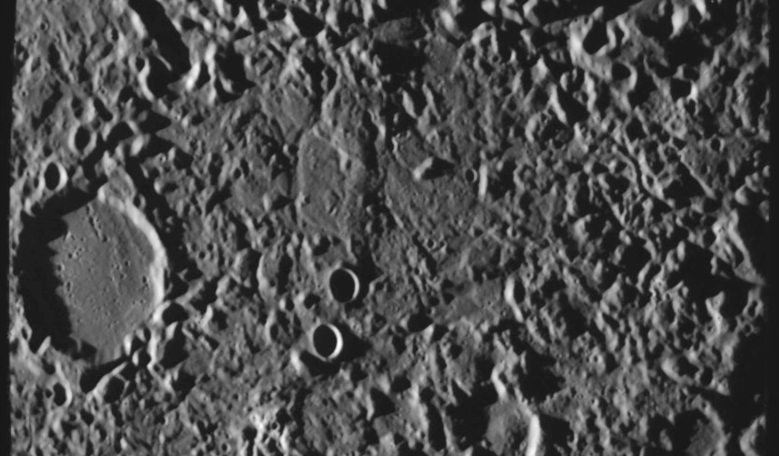Having almost no atmosphere to retain heat, a surface similar in appearance to that of the Moon, and being so perilously close to the Sun, it is hard to imagine that our smallest and innermost planet in the Solar System – Mercury – could once have hosted a habitable underground layer filled with life-loving compounds. But according to new research, scientists studying features on this divergent world, think Mercury is hiding a big secrets beneath its crust.
Scientists got their first close up look at Mercury in 1974, when NASA’s Mariner 10 spacecraft made three fly-by’s after it had visited its nearest planetary neighbour Venus.
The pictures sent back showed the planet to be strewn with vast chaotic terrains, which for nearly half a century was thought to have formed from a huge impact event.
The collision was so huge, not only did it create one of the largest impact basins in the Solar System, but it caused the surface on the opposite side of the planet to buckle and quake, leaving behind features unlike anywhere else on Mercury.
This “antipodal" terrain, or "weird" terrain as it is known as, is also littered with ejecta material from the impact which was flung so violently, it eventually converged again on the other side of Mercury near to where the crust had opened up.
The only other spacecraft to visit Mercury was NASA’s MESSENGER probe. MESSENGER orbited Mercury over 4,000 times in four years before exhausting its fuel and crashing into the planet's surface in 2015.
Before its mission ended, MESSENGER collected close to 100, 000 images of this small sun-scorched/ice-cold world. Using this imagery coupled with laser altimeter topography, a team of scientists headed by J. Alexis p. Rodriguez at the Planetary Science Institute in Tucson, Arizona, the researchers have examined Mercury’s geological features to posit that the planet’s antipodal chaotic terrain, which consists of long cracks, deep valleys and vast fields of ridges, doesn’t match up to what would have produced by the Caloris impact event around 3.8 billion years ago.
The monumental thud from the impact that would have sent shock waves coursing through the planet, would have left its mark - but not quite as big as the region associated with the antipodal terrain, say the researchers. Plus, say the team, they have identified other chaotic terrains, none of which correspond with an antipodal impact basin.
Furthermore the team suggest that Mercury’s surface was in turmoil long after the planet was struck, at least up to around 2 billion years after.
All of this adds up to region that began to collapse in on itself due to massive amounts of volatile materials escaping Mercury’s subsurface.
These volatiles, or volatile-rich compounds, include chemicals such as nitrogen, water, hydrogen, carbon dioxide and sulphates, stretched as far down as at least 2.5 kilometres, if not further and in some areas and areas were covered by magmatic hotspots that extended from from near-equatorial to subpolar regions.
As lava in the hotspots bubbled up to the surface, it caused widespread volcanic plains to form and the regional heat flow to decrease. This in turn caused a weakening of the crust as its thermal structure changed, paving the way for a gradual collapse of the surface; which in some places reached as far down as 2.5 kilometres deep.
“Our examination of the Caloris basin’s antipodal chaotic terrain reveals multi-kilometer surface elevation losses and widespread landform retention, indicating an origin due to major, gradual collapse of a volatile-rich layer,” write the team in their paper recently published in Scientific Reports.
Although all of their evidence points to a long gradual and structurally controlled collapse, the team do acknowledge that the Caloris impact could have still played a part in shaping Mercury’s terrain. “The significantly larger size of Mercury’s main chaotic terrain might be a consequence of pervasive fracturing that was inherited much earlier in the planet’s history due to the Caloris impact event, and which could have facilitated the upward release of buried volatiles,” meaning the Caloris impact could have still played a part in shaping Mercury’s terrain,” writes Rodriguez and colleagues.
The South Pole-Aitken basin, the largest, oldest, and deepest basin recognised on the Moon, is thought to have led to an epoch of volcanic activity, so it could be that the same occurred on Mercury, with the Caloris impact spreading volcanic hotspots around the planet.
However the really interesting upshot of all of this is that the early crust of Mercury could have contained a mixture of organics and ices, that from time to time might have led to "metastable and potentially habitable conditions" within these crustal materials, conclude the team.
Over the years though, these volatiles have either dehydrated, been lost to space or chemically altered by magmatic and solar heating. That is except for the material still lurking in the shadows of polar craters and perpetually covered in darkness.
It's a few years off yet, but when ESA’s Bepi-Colombo spacecraft enters Mercury’s orbit in 2025, with a suite of instruments designed to study the surface and internal composition of the planet, maybe it can provide much needed data to show whether our Solar System's habitable zone could now be expanded to include this small, tortured rocky world.











